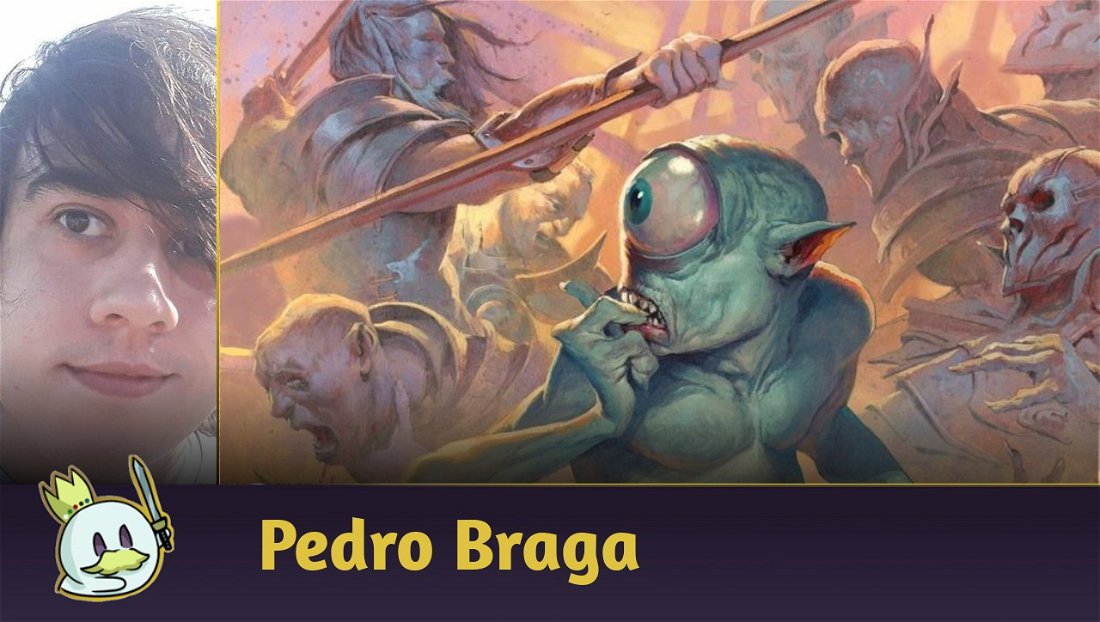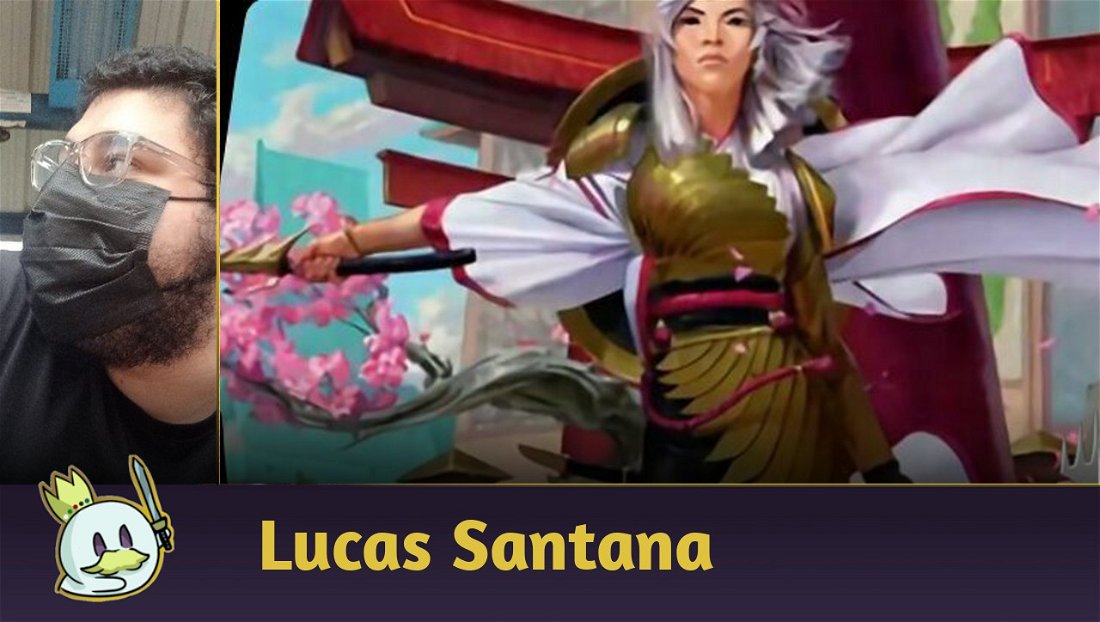A few weeks after its release, we can say that Double Masters 2022 was a huge hit on Pauper, as Monastery Swiftspear has increased the speed of the format and punishes decks that spend too much time preparing their setup, and this changed the way we look for compete in the Metagame in the last few weeks: archetypes like Mono Blue Delver are back to having some importance, while others had to adapt to circumstances, such as Boros Bully, which is playing with a lower curve and even including ramp pieces like Springleaf Drum to speed up Battle Screech and significantly increase the clock before it's too late.
Ad
However, while our focus is on Double Masters, we've also recently seen an increase in the availability of Commander Legends: Battle for Baldur's Gate cards, prompting more players to try what seems to be a multi-archetype staple today:

If we look at the last Pauper League, we had plenty of different strategies looking to take advantage of Basilisk Gate alongside the other lands of Commander Legends.
So, I decided today to bring you a brief guide to exactly how this new addition works, what makes it so important to the format, as well as considering means to combat it if the format ever becomes centered around them.
What makes Basilisk Gate good in Pauper?
It turns any creature into a threat
In short, Basilisk Gate makes basically any creature you own a wincondition as the game stretches and offers something that many Pauper archetypes lack when closing games — a significant clock boost — and it does so while these decks can abdicate the need to resort to precious slots belonging to spells for this: you just need between ten and fourteen gates (including Basilisk Gate) to take advantage of this power boost.
With that, there's (virtually) no bad topdeck among your creatures if they can deal combat damage against the opponent during a turn or two.
Gates' manabase is extremely flexible

My first Cards Realm article was during the JumpStart preview, which brought the Thriving Lands to Pauper. On it, I mentioned how the option for you to select the colors that they can generate when makes splashing absurdly easier, that would supposedly make it an essential part of the most varied Midranges.
Unfortunately, despite the Thriving Lands having collaborated to the extension of decks like Jeskai Ephemerate and the increase in Tron consistency alongside Bonder's Ornament, more interesting options have emerged, such as the Bridges on Modern Horizons II.
However, their great advantage also applies to the new Gates: the ease of splashing colors that would not normally be present on your maindeck or Sideboard with them, and we see this applied, for example, in the main list that started this search trend for the best Basilisk Gate shell, Caw-Gate:
I made an Deck Tech explaining how Caw-Gate works, and I recommend that you read it since I don't intend to delve too much into the archetype here, but we can consider it as the central focus of what elements really succeed with this theme, and there is a lot to learn from this base.
Regarding splashes, despite having a mostly blue and white base, including Counterspell, the list that won a Pauper Challenge had red and black for punctual answers against the format, such as Pyroblast and Arms of Hadar.
A considerable category of decks can use it
Unless your deck is mono colored with a fast clock (like Burn or Mono Red Blitz), has a base that doesn't allow tapped lands (like Mono Blue Delver), or needs specific lands for certain interactions (like Affinity or Rakdos Burn), you probably have a list eligible to run Basilisk Gate when removing some of your duals in favor of lands that share this permanent type.
Ad
There are a dozen archetypes in Pauper that fit this category today: Azorius/Jeskai Ephemerate, Reanimator, Boros, Izzet Faeries (Dimir needs Snuff Out to keep the positive Tempo), Monarch, among many other possibilities.
However, not all of these decks will be good enough with Basilisk Gate as the need for ten to twelve gates, in addition to the interaction concessions between your cards (such as Skred with snow lands or Cleansing Wildfire with Bridges), symbolize important changes in the way we build our lists, and it is necessary to assess how much they really make a difference for better or worse.
What strategies benefit from Basilisk Gate?
Archetypes that don't rely on specific mechanics or sheer speed to win games
Unless you're playing a deck that fully bets on speed to win, or has a specific ability or interaction that puts a lot of strain on your manabase (like basic land types for Snuff Out or artifact lands for Affinity/Metalcraft), you probably have an eligible strategy to fit Basilisk Gate — especially if we're talking about a Midrange or Control where they normally don't care about having some tapped lands along with creatures that actually make that power increase matter.
However, in theory, not every list will be able to take full advantage of this structure with the same efficiency and/or without heavier trade-offs.
Consider Faeries, for example.
Basilisk Gate is theoretically excellent in Faeries variants, as it addresses the need to cover one of the primary weaknesses of this strategy: the lack of an efficient clock after you stabilize the game. With it, you turn any Faerie Seer or Spellstutter Sprite into a 4/4 Flying in a few turns.
However, Faeries is extremely color intensive: You want two blues for Counterspell, you want two blues and one red for a backup with removal, you want three blues for cantrips that might find an answer. Because of this, resorting to a colorless land is harmful if you don't adapt your base for it — something relatively viable in the format we have today — as it doesn't fit so well into the current structure due to these requirements.
It's possible that my assumption that Faeries isn't the best alternative for Gates is wrong, and we'll see the archetype take over Pauper when people find the right shell. After all, Caw-Gate plays with Counterspell and Celestial Flare and doesn't have as many problems with color requirements, but Faeries' need to transition between beatdown and control is much more frequent, and It really bothers me about investing three mana for a power boost if we don't increase the number of lands and/or adapt the play style with more proactive elements.
Boros, on the other hand, can take advantage of this manabase with ease. It doesn't have as many heavy color requirements while its strategy naturally promotes slow play, and one of the biggest weaknesses of this archetype has always been the lack of long-term pressure — something that Basilisk Gate solves masterfully. The tradeoff, however, is having fewer targets to cast Glint Hawk aggressively without needing more lands that come into play tapped, or relying on a playset of Ancient Den and Great Furnace along with the risk of becoming an easy target for Gorilla Shaman.
Ad
Another possibility where I can see this base succeeding is in Boros Bully. After all, any 1/1 token becomes an immediate threat with this support and there are no major concessions on the list other than a speed decrease and perhaps an increase in the number of lands from 20 to 22.
That said, Gates' base doesn't offer Boros Bully as much and doesn't even cover some of its main weaknesses in the Metagame. So, maybe continuing to bet on speed is the best proposal today.
As I already mentioned, the Gates open up numerous splash possibilities, and NotGood's list takes that idea to the max with this 5-Color Ephemerate, which has the support of Abundant Growth to have access to any color in addition to offering the classic interaction with Kor Skyfisher in the same way that we saw with Arcum's Astrolabe.
In these Ephemerate variants, Basilisk Gate has the inevitability that at some point your flying creatures will attack without blocking, and at that moment, the fact that you naturally take the game to late-game makes Gates' base extremely efficient in terms of power boost, easily enabling a three or even two-turn clock.
Speaking of Ephemerate, the low deckbuilding concession required allows you to add Gates to literally any archetype that doesn't care so much about Early-Game, even in a combo like Tireless Tribe with Inside Out, where activating the land along with Shadow Rift means dealing a considerable amount of damage on later stages — not to mention that Mulldrifter and Seeker of the Way are also great targets for it.
And speaking of combos, one of the greatest benefits of Basilisk Gate is giving Infect means to play without resorting exclusively to the "creature + pump" proposal, making room for more interaction and the certainty that, if the game extends, you have the inevitability to deal 10 damage with a creature and win the game instantly.
Some other lists are running Blighted Agent to play around Lifegain.

To make any Infect creature a combo-kill, you need at least six lands, including 5 Gates, with at least 2 Basilisk Gates to activate both and kill in the same turn, but you can mitigate this sum in two or three turns.
While I see a lot of potential in this combination, I'm not confident that the right shell has yet been found, let alone that Gurmag Angler is a necessary element when other creatures are betting on ignoring opposing life totals.
What do I need to run Basilisk Gate in my deck?
If we look at all the lists that played Basilisk Gate in the last few weeks, we can see the following patterns:
A manabase that supports Gates without making your game plan worse

With this land category almost always entering tapped, they don't fit as well in more aggressive archetypes and work best on lists that don't mind having no plays in the first few turns, while working well if they come in turn 3 or 4 with cheap spells.
Ad
The best option probably involves Midranges, but we can also see other categories of Control or long-term combos taking advantage of them.
Creatures with abilities that benefit combat
Activating a Basilisk Gate on a Phyrexian Rager means very little if it is blocked and/or even if it damages the player. The best targets are creatures that have some sort of evasion and/or relevant ability at the combat phase.

The evasion part is the simplest and has been amply exemplified here: any 1/1 with Flying is a threat with Basilisk Gate, and the same goes for creatures that can't be blocked and/or have some built-in protection that makes combat difficult, such as Guardian of the Guildpact.

Other abilities that matter when a creature is attacking, such as Trample, Lifelink, and Double Strike are powered up by Basilisk Gate. After all, 4 Lifelink damage is another 4 life you gain to slow your opponent's clock.
How to fight Basilisk Gate?
If Gates becomes Pauper's default manabase, that doesn't mean they're invincible and we don't have the means to fight it in the format - I think these three proposals are the most effective in dealing with them if they ever become predominant in the competitive landscape.
Be Faster

Gates tend to require an amount of tapped lands to operate, regardless of strategy. This opens up the opportunity to beat them through racing with more aggressive archetypes like Mono Red Blitz or Burn, through Tempo with Mono Blue Faeries or, who knows, even with a variant of Dimir Delver, plus with faster versions of Affinity, or even more traditional versions since you can establish a better clock with much less mana investment.
Go for the Lands

It seems kind of obvious, but Gates don't have the same LD resilience as Bridges or Tron, making them an easy target for variants of Jeskai Ephemerate or Cascade that resort to the interaction between Bridges and Cleansing Wildfire and/or that accelerate mana with Mwonvuli Acid-Moss to hit the manabase of the greediest lists or destroy the main engine of this strategy, Basilisk Gate.
I even believe that if Gates become more prevalent in the Metagame, we will see an addition of Cleansing Wildfire archetypes to fight them, creating a new Rock-Paper-Scissors sphere in Pauper.
Instant-Speed Removals

This seems kind of obvious, but Basilisk Gate is exclusively activated at Sorcery-Speed and requires a three mana investment to generate the pump — this creates a massive response window to deal with any creature your opponent makes this investment of resources, preferably with something that costs less mana than they invested.
Ad
Among the available options, I categorize this as the least efficient as most archetypes will have more than just one threat and this will force you to constantly look for a removal to make the trade, but I emphasize that an increase in Instant-Speed interactions can be needed if Gates grows too large in Pauper.
Conclusion
That's all for today.
Gates can definitely impact Pauper in a way I didn't expect when they were announced in Commander Legends, bringing a new angle and proposal to the most varied strategies.
That said, I don't think they will break the format in any way, as there is a lot of room for adaptation, and the more players dedicate themselves to resorting to these lands, the more answers and means to combat we will see from the rest of the Metagame.
My concern, however, is the decks that are already established in the competitive scene and can benefit from them while retaining the basis of their strategies to the point of mitigating part of their natural weaknesses: a classic example would be Faeries, and I believe it's only a matter of time before a strategy like this finds the best way to take advantage of the Gates without over committing their proposal.
However, until that day arrives (if it ever arrives), I see the new lands and Basilisk Gate as a great addition to Pauper, and it moves the Metagame even more by opening up a multitude of possibilities.
Thanks for reading.







— commentaires0
Soyez le premier à commenter